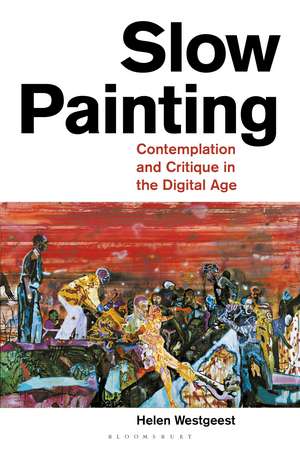Slow Painting: Contemplation and Critique in the Digital Age
Autor Helen Westgeesten Limba Engleză Paperback – 18 mai 2022
| Toate formatele și edițiile | Preț | Express |
|---|---|---|
| Paperback (1) | 197.77 lei 6-8 săpt. | |
| Bloomsbury Publishing – 18 mai 2022 | 197.77 lei 6-8 săpt. | |
| Hardback (1) | 598.24 lei 3-5 săpt. | |
| Bloomsbury Publishing – 25 noi 2020 | 598.24 lei 3-5 săpt. |
Preț: 197.77 lei
Preț vechi: 257.87 lei
-23% Nou
Puncte Express: 297
Preț estimativ în valută:
37.86€ • 41.13$ • 31.82£
37.86€ • 41.13$ • 31.82£
Carte tipărită la comandă
Livrare economică 21 aprilie-05 mai
Preluare comenzi: 021 569.72.76
Specificații
ISBN-13: 9781350283572
ISBN-10: 1350283576
Pagini: 240
Ilustrații: 26 bw illus
Dimensiuni: 156 x 234 x 18 mm
Greutate: 0.34 kg
Editura: Bloomsbury Publishing
Colecția Bloomsbury Visual Arts
Locul publicării:London, United Kingdom
ISBN-10: 1350283576
Pagini: 240
Ilustrații: 26 bw illus
Dimensiuni: 156 x 234 x 18 mm
Greutate: 0.34 kg
Editura: Bloomsbury Publishing
Colecția Bloomsbury Visual Arts
Locul publicării:London, United Kingdom
Caracteristici
Links "slow painting" to other socio-political movements that resist quick & easy consumption in the modern era like "slow food" and "slow fashion"
Notă biografică
Helen Westgeest is Associate Professor of Modern & Contemporary Art History and Photography Theory at Leiden University, The Netherlands., and worked as field editor for photography at caa.reviews. She has published several articles in peer-reviewed journals, as well as two monographs and two edited collections. Her research interests are how the medium produces meaning in the visual arts, contemporary art, the theory of photography, and video art and artistic interactions between the East and West.
Cuprins
AcknowledgmentsIntroductionPart 1: Photographs Transformed into Socio-Critical Paintings Chapter 1. Paintings Consolidating Fleeting Press PhotosCase-study of Daniel Richter's Phienox (2000) The Fast Immediacy of Action Photography Turned into the Slow Immediacy of Painting ActionsThe Indirectness of Photo-Reproducibility Slowing down the Perception of the Hosting PaintingThe Corporality of Paintings That Include News PhotosBridging Distances in Time through History Painting and Histories of PaintingExperiencing the Absence of Text: Mind the GapChapter 2. Collage Paintings Sparring with Visual PropagandaTwo Case-studies: Kerry James Marshall's Great America (1994) and Jaune Quick-To-See Smith's Spam (1995) Debates on Paintings Including TextCollage Paintings Returning Physicality to Collages in the Digital AgeFeminists' Aversion to and Rediscovery of Painting in Collage PaintingsThe Power of Visual Political Propaganda Interrogated and AppliedThe Rhetoric of Commercials Applied in Collage PaintingsChapter 3. Slow and Socio-Critical Painting-like Digital PhotographsCase-study of AES+F's Last Riot 2, Tondo #22 (2006)Debates on Digital Imagery's Relationship with PaintingParasitizing on the "Truthfulness" of War Photography and Artistic Truth in History Paintings Space-Time Compressions and "Fakeness" in Constructed Digital PhotographsPart 2: Painting as Socio-Critical Time-Based-ArtChapter 4. Painting Actions Materializing Social RelationshipsTwo Case-studies: Pawel Althamer's Draftmen's Congress (2012) and Artur Zmijewski's Them (2007)Painting as a Verb: From Action Painting to Painting as Socio-Critical ActionPainting in the Expanded Field: Entering the Space of PaintingsDelegated Performance: The Social Space of PaintingChapter 5. Socio-Critical Expanded Paintings through Veiling and Unveiling Case-study of Jasmina Metwaly's Tahrir Square: Metro Vent (2011)Video Art's Relationship with Painting The Screen as Canvas: Centripetal Images Evoking Critical ContemplationFunctionally Disturbed Moving Images as Video PaintingsThe Dynamics of Digital Video Technology as Metaphor for Social MemorySlow and Boring Videos Challenging Perception and Interrogating StillnessConcluding RemarksBibliography
Recenzii
Slow Painting roundly rebuts the notion that painting has been made obsolete by lens-based media or digital developments. On the contrary, Helen Westgeest argues for painting's relevance as a contemporary medium that is flexible, vibrantly political and endlessly renewing. This masterful, accessible book provides a rallying point for discussions of painting in the twenty-first century.












